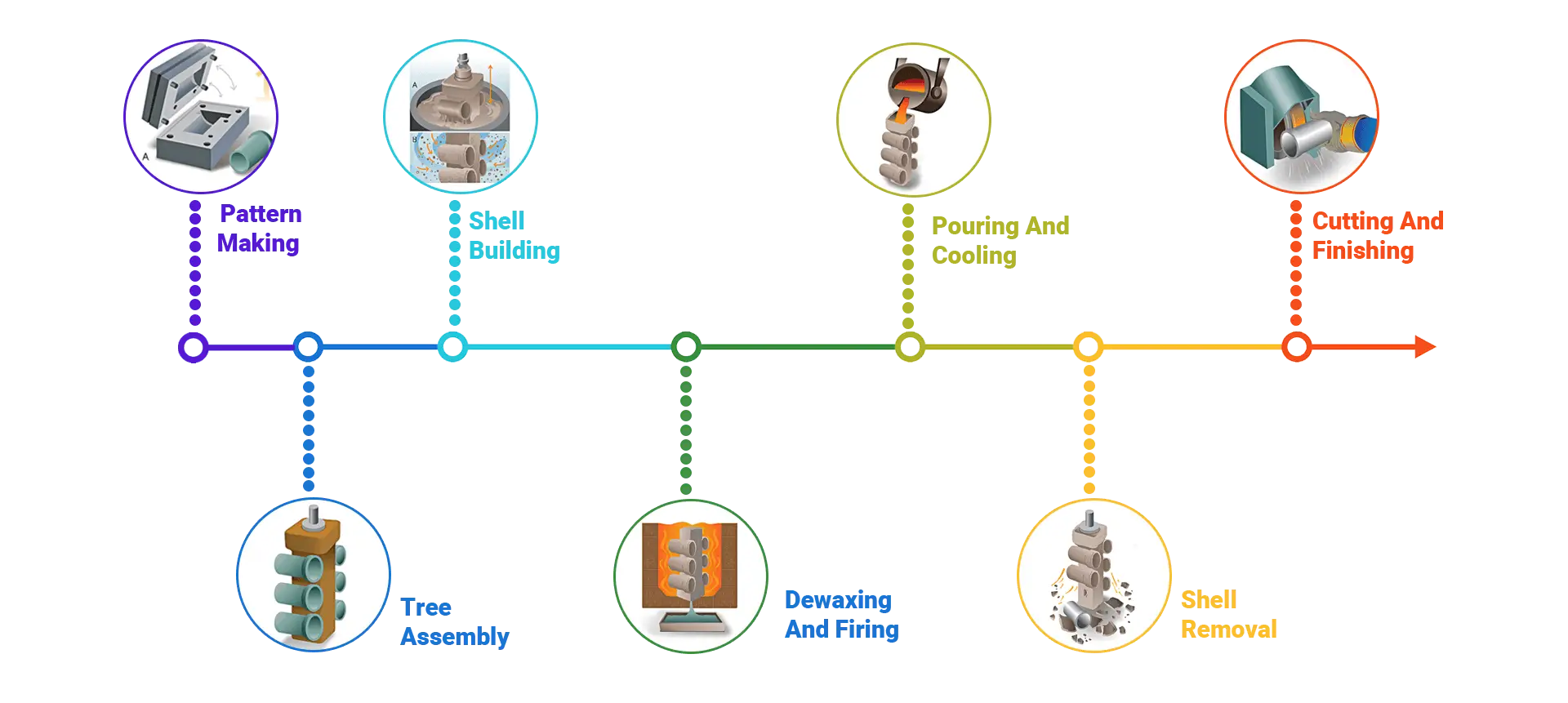Investment Casting
Investment casting, also known as lost-wax casting, is a precision manufacturing process ideal for creating precision metal components with tight tolerances and smooth surfaces. Our facility specializes in producing high-quality castings from stainless steel, aluminum, and titanium, delivering intricate parts that meet the most demanding requirements across various industries
Available Materials For Investment Casting
Here is the list of available metals for pressure die casting. If you need any customized materials, please get in touch with us.
Parameter of investment casting process
Below are the most common parameters for investment casting process
| Materials | Properties | Parameters |
|---|---|---|
| Stainless Steel (e.g., 304, 316) | Excellent corrosion resistance, high strength, good weldability | Yield Strength: 205 MPa (304), 290 MPa (316) Hardness: 70 HRB (304), 95 HRB (316) |
| Aluminum Alloys (e.g., 6061, 7075) | Lightweight, good corrosion resistance, high strength-to-weight ratio | Yield Strength: 276 MPa (6061), 570 MPa (7075) Hardness: 95 HB (6061), 150 HB (7075) |
| Titanium Alloys (e.g., Ti-6Al-4V) | Exceptional strength, low density, excellent corrosion resistance | Yield Strength: 880 MPa Hardness: 36 HRC Density: 4.43 g/cm³ |
| Copper Alloys (e.g., C954, C958) | Good thermal and electrical conductivity, excellent machinability | Yield Strength: 345 MPa (C954), 310 MPa (C958) Hardness: 80 HRB (C954) |
| Nickel Alloys (e.g., Inconel 625) | High strength, oxidation resistance, excellent weldability | Yield Strength: 345 MPa (C954), 310 MPa (C958) Hardness: 80 HRB (C954) |
| Parameters | Features |
|---|---|
| Geometrical Complexity | Capable of handling complex geometries, including small holes, internal passages, and thin-wall designs |
| Minimum Tolerance Range | ±0.1 mm (can provide tighter tolerances based on specific requirements) |
| Surface Quality (Roughness) | Ra 3.2 - 1.6 μm (can achieve smoother surfaces depending on customer needs) |
| Maximum Size | Maximum single piece size up to 600mm x 400mm (specific dimensions can be adjusted based on project requirements) |
| Material Types | Stainless steel, aluminum alloys, titanium alloys, suitable for various industrial applications |
7-Step Precision Casting Process

1.Pattern Making
Wax patterns are created using a metal mold to form the basic shape of the desired part
2. Tree Assembly
Multiple wax patterns are attached to a central wax sprue to create a “tree” for batch production.
3. Shell Building
The wax tree is repeatedly dipped in ceramic slurry to build a strong, heat-resistant shell.
4. Dewaxing & Shell Firing
The ceramic-coated wax assembly is heated to melt out the wax, then fired to harden and strengthen the shell.
5. Metal Pouring & Cooling
Molten metal is poured into the preheated shell, then left to cool and solidify, forming the final metal part.
6. Shell Removal
The ceramic shell is broken away to reveal the rough cast component.
7. Cutting & Finishing
The parts are cut from the sprue and undergo surface finishing, machining, and quality inspection.
Specialist Industries
We have manufactured millions of parts for various applications, with particular expertise in the following areas.

Automative
Ideal for complex parts including engine components, transmission parts, etc, providing excellent strength and weight reduction.

Aerospace & Aviation
produce high-precision components like turbine blades and structural parts, ensuring reliability and performance under extreme conditions.

Kitchen Appliances
Enables the production of precise, durable, and visually appealing parts to ensure excellent surface finish and dimensional accuracy
FAQ
MOST FREQUENT QUESTIONS AND ANSWERSQ1: What materials can be used in Investment Casting?
A1: Common materials include aluminum, zinc, magnesium, and copper alloys, chosen for their properties like strength, lightweight, and corrosion resistance.
Q2: What are the main advantages of Investment Casting?
A2: Investment casting offers excellent surface finishes, tight dimensional tolerances, and the ability to produce intricate shapes with complex geometries, making it ideal for high-precision components.
Q3: What is the typical dimensional tolerance achievable?
A3: The process can achieve tolerances as tight as ±0.1 mm, depending on the part’s size, design complexity, and material used.
Q4: What is the maximum size of parts that can be produced using Investment Casting?
A4: Investment casting is generally suitable for parts up to 600mm in size, but larger components can be produced depending on the design and material requirements.
Q5: How complex can the part geometries be?
A5: Investment casting is capable of handling complex geometries such as thin walls, internal passages, undercuts, and intricate details that are difficult to achieve through other casting methods.
Q6: What are the typical surface roughness values achievable?
A6: Surface roughness typically ranges from Ra 3.2 to 1.6 μm, but smoother finishes can be achieved through secondary processing if needed.
Q7: How does Investment Casting compare to Sand Casting?
A7: Investment casting offers better surface quality, tighter tolerances, and more complex shapes compared to sand casting, making it ideal for high-value, precision applications.
Q8: What industries commonly use Investment Casting?
A8: The process is widely used in aerospace, automotive, medical, and industrial sectors where high-precision, strength, and complex geometries are required.
Q9: What is the lead time for Investment Casting parts?
A9: Typical lead times range from 4 to 6 weeks depending on the complexity of the part, production volume, and any post-processing requirements.
